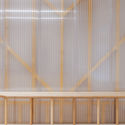
-
Architects: DK-CM
- Year: 2021
-
Photographs:Neil Perry
-
Manufacturers: Stora Enso

Text description provided by the architects. A new dance school, events space, and artists’ studios have been carved out of dilapidated and disused historic outbuildings. This work is the first phase of a 6- year masterplan, developed by the practice to support this well-loved and popular cultural campus to grow and become sustainable and self-sufficient.



















